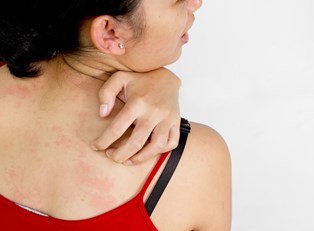There is an endless buffet of triggers guaranteed to send your rosacea into flare-up mode, and while many factors such as the weather or stress are beyond your control, dietary triggers usually are not. Since there is no cure for rosacea, living with this skin disease means pinpointing the triggers that are causing your flare-ups and minimizing your exposure to them.
Understanding Inflammation
Some experts believe rosacea is an inflammatory process that occurs when the blood vessels in your face constrict and dilate. Cold temperatures, intense exercise, and strong emotions can cause vasoconstriction, while heat causes vasodilation. The more back-and-forth your blood vessels experience, the more irritated your skin may feel, and this is why both extremes are to be avoided as much as possible. Certain drugs, such as blood pressure medications, may also cause either effect on the blood vessels.
Foods and Inflammation
The foods you eat and their temperatures can cause the same vasoconstriction or dilation of the blood vessels in your face. Concentrated foods such as spices and condiments are common triggers.
Experts also believe your skin inflammation may occur as an immune response to excessive acidity, and some recommend abandoning acidic foods for an alkaline diet. Consult with your physician about what dietary options might be right for you.
Common Rosacea Triggers
Below is a list of common dietary triggers your dermatologist will likely suggest avoiding. While it is not all-inclusive, the list contains many of the foods that can trigger rosacea flare-ups.
-
Spicy foods: ethnic foods, cayenne pepper, black pepper, white pepper, curry, horseradish, wasabi, and cinnamon
- Fermented foods:
alcohol (especially red wine and beer), aged or sharp cheeses, yogurt, sauerkraut, and kimchi
- Acidic foods:
anything pickled, olives, vinegars, and marinades
- Cured or smoked foods containing nitrates and nitrites:
bacon, hot dogs, deli meats, sausages
- Foods high in histamine:
spinach, eggplant, cheeses, sour cream, citrus fruits, tomatoes, avocados, figs, and raisins
- Foods high in niacin:
liver and yeast
- Other triggers include:
sugars, pasta, chocolate, and caffeine.
Additional Tips
Eating a well-balanced diet, including healthy amounts of fruits and vegetables and drinking plenty of water, can serve to reduce flare-ups. Eating oily fish or taking supplemental fish oils containing omega-3 and omega-6 fatty acids have been recommended for reducing inflammatory effects, as well as reducing symptoms of dry skin. Avoid hovering over steaming pots and flaming grills while cooking. Because temperature alone can trigger a flare-up, give soups and hot beverages a chance to cool before sampling. Experiment with seasoning your dishes with fresh herbs rather than spicy sauces and acidic condiments.



